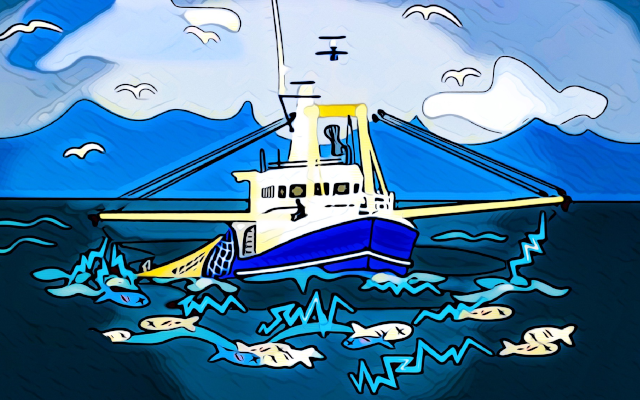The Netherlands has appealed to the European Court of Justice against the total ban on electric fishing established in the EU as of 1.7.21. (1) Claiming the right to continue dredging-and depopulating-the North Sea by means of 80 Dutch-flagged vessels with electrified nets. Which cause flatfish to twitch in order to make them emerge from the bottom and make it easier to catch them.
Electric fishing, the British scientific study
The scientific study by the Centre for Environment, Fisheries and Aquaculture Science (CEFAS), a British government agency, shows that electric fishing reduces wildlife biodiversity in the seabed by up to 57 percent.(2)
The researchers compared the biodiversity of two fishing grounds, in British waters, similar in size and bottom composition. Two equivalent ecosystems, only one of which was dredged by trawlers employing electrified nets.
Two sampling methods were used to assess the population and variety of fish species, in the two areas. By means of trawls and benthic trawls (i.e., those used to collect prey that are on or near the seabed, such as paranza).
Electric fishing halves bottom fauna
The results of the study show the serious damage to biodiversity in the area subjected to electric fishing. In comparison with the marine area not subject to this fishing method, fish species are reduced by 57% in benthic trawl sampling, 21% in trawl sampling.
As many as 17 species of fish present in the area exempt from electric nets have disappeared in the ‘electrified’ one. Among the most affected species are common sole(Solea vulgaris), decreased by 2.6 times, and skates(Raja asterias), decreased by half. Catches, in the area covered by electric fishing, have halved (-47%). And the marine ecosystem is drastically altered, with significant increases in the concentration of hermit crabs (to be attributed to the extermination of their natural predators).

Electric fishing, still two years of shocks
Banned in Europe for more than two decades (1998), electric fishing has in fact never disappeared. (3) Through a swing of waivers, granted in a 5 percent quota on each member state’s trawler fleet operating in the southern North Sea. Electric fishing is thus still practiced by 84 Dutch vessels (2018 data).
Irreparable damage to marine biodiversity, but also an economic loss for traditional fishing boats. Predominantly French- and British-flagged. In the short run as well as the long run. Thus, strenuous opposition to electric fishing was formed. On the civil society front is Bloom, the NGO that has been campaigning relentlessly since 2017. And the European Parliament finally voted-at its April 2019 plenary session-to ban all electric fishing in the EU, effective 1.7.21. (4)
The Dutch government, however, opposes this. The Dutch were the first to adopt this method of fishing, back in 1992, and they persist with it. (2) After all–as the British study (which was supported by the domestic fishing industry) shows–electric fishing is devilishly beneficial to those who engage in it. At least in the immediate term, until the North Sea is finally depopulated. As catches increase and fuel consumption of fishing vessels decreases due to lighter nets and slower pacing.
What about us, what can we do? Avoid buying sole from the North Sea, FAO zone 27, to begin with.
Eat Local, Buy Local, Act Global!
POF(Profit Over Fishing), no thanks.
Notes
(2) SEE https://it.scribd.com/document/430606618/Cefas-Impact-Electric-Fishing
(3) ‘Itis prohibited to catch marine organisms by methods involving the use of explosives, poisons or narcotics or electric current.’ Article 31, Unconventional fishing methods, reg. (EC) 850/98
(4) https://www.bloomassociation.org/en/electric-fishing-buried-by-european-parliament/
Professional journalist since January 1995, he has worked for newspapers (Il Messaggero, Paese Sera, La Stampa) and periodicals (NumeroUno, Il Salvagente). She is the author of journalistic surveys on food, she has published the book "Reading labels to know what we eat".








